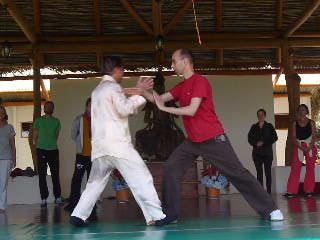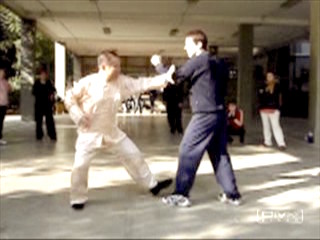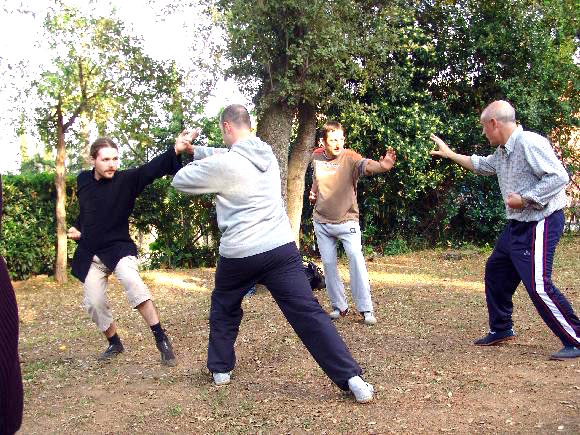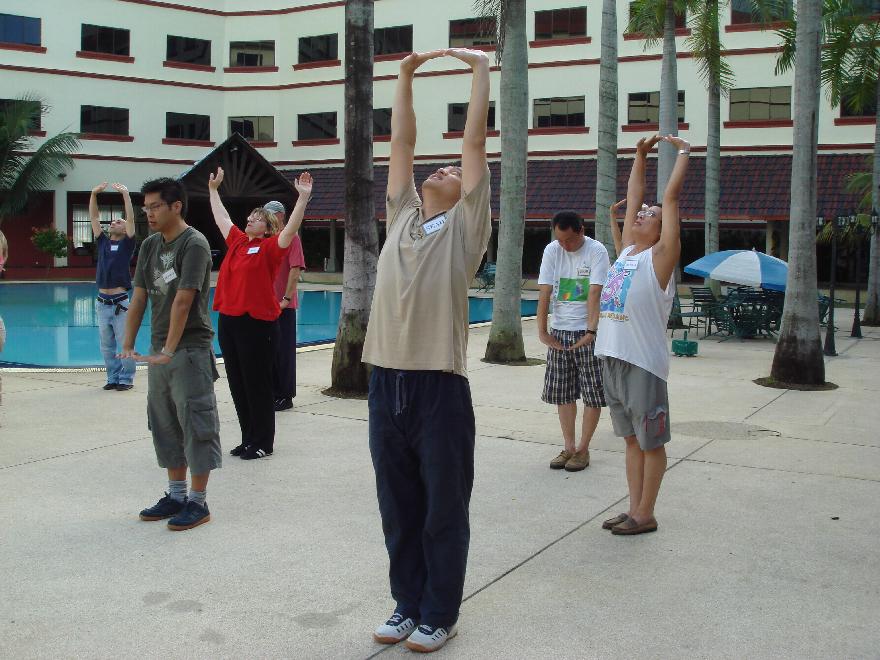August 2009 (Part 1)
SELECTION OF QUESTIONS AND ANSWERS

An effective way to slow down an opponent in Taijiquan is to bridge his arm using "Immortal Waves Sleeves"
Question 1
At the Tai Chi Chuan Intensive Course you mentioned how to slow down opponents. One way was to bridge their attack with "Immortal Waves Sleeve" and exert pressure or close them to unbalance them and thus slow them down as they attempt to press.
Another way seemed to be to match their speed to defend their strikes then to either strike slower or to take longer on the defence pattern thus slowing the exchange of attacks down.
I wonder whether my understanding is correct in the above paragraphs and also whether you would give me any further advice on slowing down opponents.
— Sifu Jonny Say, Scotland
Answer
Yes, your understanding of slowing down opponents is correct. There are other ways of slowing down an opponent too. I shall describe them, including the two you have mentioned, systematically.
We may slow down an opponent's attack in three main ways, namely using different points of time, using tactics and using techniques. For easy explanation, let us take a simple attack, like a right "Black Tiger Steals Heart".
You can choose to respond at the initial point of an opponent's attack, at the mid point or at the concluding point. As an opponent starts to attack, you stop his right "Black Tiger" with your left "Single Tiger", and counter with your right "Black Tiger". You will need about 1 to 1.5 seconds for your counter.
Or you may ward off his "Black Tiger" when it is about mid way in its thrust, and counter-strike. You will need about 1.2 to 1.8 seconds in your counter.
Thirdly you can move back into a False-Leg Stance and let his "Black Tiger" complete its thrust before brushing it away. Then you move forward again to a Bow-Arrow Stance to execute your counter. This will take about 1.5 to 3 seconds.
The difference in time of slowing down is not much, ranging from 1 to 3 seconds. Actually, this mode is used for the reverse purpose, to speed up the counter, where a difference of 1.5 second can be significant.
Regarding counter-tactics, there are three levels, namely "first defend then counter", "defend-cum-counter", and "no defend direct counter". The examples above involve "first defend then counter", which is the slowest.
Now, instead of warding off his attack with a Tiger-Claw, you brush it off with your left palm and simultaneously counter-attack with your right palm, using the pattern "Green Dragon Shoots Pearl". This is "defend-cum-counter", and you will need just a second for this move.
You can speed up the attack even further using the tactic of "no defence direct counter". As your opponent attacks you with a "Black Tiger", you thrust out your "Poisonous Snake" at his throat, brushing away his attack on the way. You can strike him in 0.5 to 0.8 second.
As in the case of the three points of time, the difference in these three levels of counter-tactics is not much in slowing down an opponent but significant in speeding up our counter. Nevertheless, if you wish to slow down an opponent, you should choose to respond at the third point of time and use the tactic of "first defend then counter".
The slowing down effect is great in the third method, using techniques. As your opponent attacks with a right "Black Tiger", you may brush off his attack with a left "Single Tiger" and counter strike with a right "Black Tiger". Here you have to be relatively fast - before he can attack with his left hand or continue with any other attack. If you slow down your movement but without sacrificing your safety, you take about 2 seconds to defend then counter attack.
Instead of brushing off his attack with a left "Single Tiger", you may close his attack with your left Tiger-Claw but using "Wave Dragon Back to Den". You hold his right elbow with your left Tiger-Claw and strike him with your right "Black Tiger". Here you slow down the opponent. You are also safe, as you keep him under control before counter-attacking. Here you take 3 or 4 seconds.
Thirdly, instead of brushing off his right attack with your left "Single Tiger", you do so with your right "Single Tiger". Then you grip his arm and pull it across his body to cover his left hand so that he cannot attack you. You may, if you like, further slow down his movement by maintaining this position for a few seconds. Then you change from holding his right arm with your right "Single Tiger" to holding with your left "Single Tiger".
Again, you may, if you like, maintain this position for a few extra seconds, before slowly striking him with a right "Black Tiger". In this position you can take your time to attack him because you are keeping him under control whereby he cannot attack you If he tries to move back or move away from your control, you close in to bridge the gap.
Using the third method, even when you do not purposely slow down further by maintaining your position without countering, you can take 4 to 6 seconds, which is about 3 times slower than the first counter. There are two occasions when you can further slow down, and if you take 3 seconds for each occasion, you would take about 10 to 12 seconds for this counter.
Hence, when an opponent attacks you with "Black Tiger Steals Heart", if you wish to speed up your counter, you can respond at the first point of time with the tactic of "no defence direct counter" using the technique "White Snake Shoots Venom". You will strike him a split second after he starts his attack. If you wish to slow him down, you can respond at the third point of time with the tactic of "first defend then counter" using "Single Tiger" and "Black Tiger". You can slow down your counter to 12 seconds.
Question 2
I find when I spar with partners who are fast and reckless it is difficult not to get hit once, I may dominate the exchange but if they are fast and reckless they may hit me occasionally. To develop this skill of slowing down an opponent would be invaluable.
Answer
One reason why you may be hit occasionally when sparring with fast partners is that you focus on attack rather than defence. This is understandable because generally our sparring strategy is on attack but without neglecting our defence.
However, in exceptional situations, like when facing very fast opponents or when we want to access our opponents instead of just hitting them, you may modify our normal strategy to focus on defence instead. In the examples above, after having cover or close your opponent with your "Single Tiger", you purposely don't attack him even though you can. You keep him in check while waiting for his next move.
If you have covered him well, he would be unable to strike you. To strike you, he has first to free himself form your coverage. He may, for example, move a step back or sink his body, and strike you or kick at you. Normally you can intercept his second attack and counter.
But if he is a very fast opponent, he may execute another attack while you are engaged in your first counter. If he is tricky too, his second attack may be a feint, and half way through it he changes into a third strike or kick. If you are focused on attacking, you may be hit. And when you are hit once, you may be hit again and again.
So, instead of countering, you ward off or avoid his strike or kick, and continue to cover him. Your covering movement should be slow. And when he least expects it, you strike him. Once you hit him, you continue hitting him, without neglecting your coverage.
Instead of striking him, you may apply chin-na on him or fell him onto the ground and execute a coup de grace when he is fully under control.

Closing an opponent using "Single Tiger Emerges from Cave" or "Wave Dragon Back to Den" is another effective way to slow down an opponent
Question 3
I have a very frightening and deeply personal problem, the likes of which I have never experienced before. You are the greatest healer I know, and I do not want to turn to medication, which I know would not solve my problem.
— Tom, USA
Answer
You are a victim of your own fear and intellectualization. But your problem can be overcome if you follow my advice, as follows.
Question 4
Basically, about three weeks ago I did something I should not have, which led to severe panic attacks which still come and go, even though I think I have no logical reason to be afraid any longer. I am shocked and confused, because after nearly one month, the back of my neck is still burning, my feet are warm, I sometimes shiver, while at times my heart may pound and my body may shake.
Answer
This is a good example of your mind affecting your body. Because you habitually think back of your wrong actions and intellectualize on the harm that could be done, you body reacts accordingly to what your mind thinks.
What should you do? Simple, if you want to do it and overcome your problem. First, don't think back of the wrong things you did. Two, think of good things instead.
You can combine the two actions into one, as follows. Don't think of the mistakes you did. But if the mistakes still surface into your mind, change your thoughts into something pleasant, like thinking of how lucky you are to be able to overcome your problem.
If you, like many people, believe that you cannot stop thinking of your mistakes and intellectualizing, strongly decide now and here that this is a perverted thought that can be eliminated. Take an analogy. Suppose you are driving and you see a wall a hundred feet in front. What do you do? Simple, just stop your car.
Do you say that you can't stop your car? If you start intellectualizing whether you can or cannot stop your car, or what would happen if you don't stop your car, you would hit the wall.
It is the same with your thinking. Just stop thinking of your past mistakes and intellectuzlizing what would happen. Just do it. In fact, it is easier to stop thinking than to stop your car.

You may respond to an opponent's attack at three points of time - at the initial, the medial and the conclusion
Question 5
Three weeks ago I came across a recording online that is supposed to hypnotize listeners into a state of arousal and eventually orgasm. ... I screened the recording without actively participating and it was frankly so sick and inappropriate that I should have deleted it immediately. ... However, somehow it got into my head that I could have a little fun with the recording. ... and then I had my first panic attack in years. ... I realized that I'd been playing with fire for no good reason.
Answer
It is very good that you know the recording is harmful and that you had been playing with fire for no good reason. Now, destroy the recording and throw it away. It is that simple, but do it immediately after reading this advice and before you read further.
Question 6
What was worse was that I still felt aroused due to associations I already had before ... I associate sexual arousal with an altered state of consciousness. Of course, in my fantasies, not only it is happy to be swept up in it, it's possible to return to normalcy at any time. I knew the recording was more dangerous than a fantasy, but I guess my body was confused. That made me worried, though, that I was affected by the recording.
Answer
Now that you have destroyed and thrown away the recording, do not think about it any more. Let it be the past, and you move on wholesomely with your life.
You need not intellectualize whether sexual arousal is an altered state of consciousness. If it is, fine. If it isn't, fine too. What is important is that your sexual arousal should be healthy and natural, and when it happens, enjoy your arousal, with or without a willing partnrer, but without any intellectualizing

"Lifting the Sky" is an excellent exercise that can help to overcome phobia
Question 7
The audio clip strove to create many associations with the word "loop" so it would activate a post-hypnotic trigger. The word was connected to a lot of things... certain sexual caresses, like from a woman's breasts, which are likened to an infinity symbol, which is liked to a never-ending "loop" of arousal connected to the recording, of which just about any loop out there is supposed to be a reminder-- there is even a suggestion to loop the recording. Once my fear caught up with me, I started seeing loops everywhere.
Answer
Associating a woman's breasts to a loop or to an infinity symbol is just one possibility. There are other possibilities. Choose one that you like and that gives you warmth and confidence.
For example, you may associate a woman's breasts to a mother's loving care for her children, or to God's grace in making women besides men. So, the next time you see a loop, think of your mother's loving care or God's grace.
Question 8
I was getting really upset about compromising control of myself, and I had a severe panic attack that lasted for days, before it subsided into a usually dull burning in the back of my neck. I also had no appetite. I actually performed chi kung activities twice or sometimes three times a day, mostly Lifting the Sky, which I believe helped. I was able to function well enough to teach my English classes normally,
Answer
Your problem was self-made. You chose to get upset about compromising control of yourself. The panic attack and the lost of appetite were the effects.
The important thing is that you have a choice. You are different from those who have problems like cancer or heart disease. They did not choose to have cancer or heart disease, but you chose to get upset about compromising control of yourself.
But what was past, was past. You need not intellectualize what would happen had you not been upset or had you not compromised yourself, or had you made another choice.
Don't intellectualize but do choose differently and wisely. Choose to be confident that you have good control of yourself to think good, speak good and do good.
Question 9
I actually listened to parts of the recording again with the intention of challenging it. It upset me, but I was not moved by its suggestions and relaxed significantly. I figured I was cured. I resumed normal sexual activity ... I'd occasionally see a loop, but it didn't mean anything to me.
Answer
Congratulations for your initial success. But initial success is not enough.
Now that you have thrown away the recording, you would not listen to it again. There is no need for you to challenge it, and there is no need to be upset. As I have said earlier, you have a choice. Just choose not to even think about the recording, and being upset would be irrelevant. Instead, choose to think good, speak good and do good.
Editorial Note Tom's other questions will be continued in the next issue, August 2009 Part 2 .
LINKS
Selected Reading
- Zen, Buddhism and Spiritual Cultivation
- What is Genuine, Traditional Taijiquan
- Fun in Breaking Fall
- Four Felling Techniques in Fell Tree with Roots
- What you Learn at the Intensive Chi Kung Course
